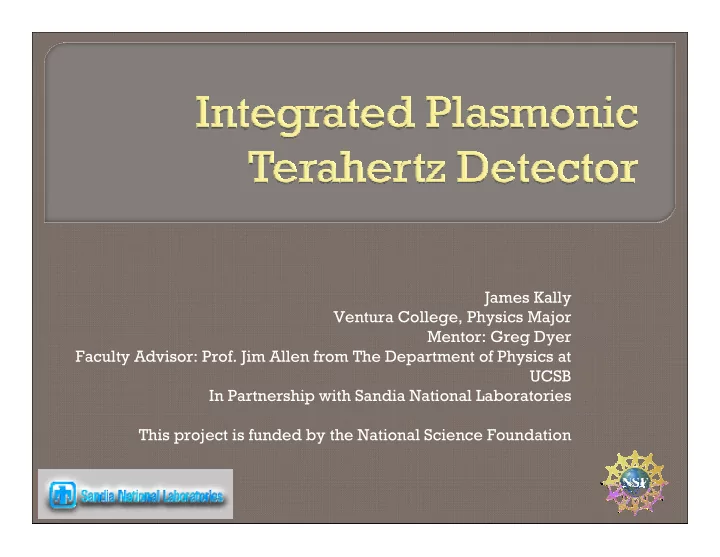

James Kally Ventura College, Physics Major Mentor: Greg Dyer Faculty Advisor: Prof. Jim Allen from The Department of Physics at UCSB In Partnership with Sandia National Laboratories This project is funded by the National Science Foundation
� Terahertz Spectrum • Technology gap • Engineering difficulties • No known health risk � Applications in: • Medical • Military and Homeland Security • Categorizing proteins and molecules
� Characterize terahertz detectors � Special type of transistor � Plasmonic THz Detector � THz radiation excites plasmons (electrons) � Tunable, narrow-band detection � Focus on a single device � Measure THz response � Correlate transport characteristics � Develop a model of transport within the device
� High Electron Mobility Transistor (HEMT) Source • Uses electrons for transport • Thin layer of electrons creating 2D electron gas Grating Gates • Gate is applied with negative I voltage to limit flow Finger Gate Grating Gates Drain Source Drain Grating Gates couples radiation • GaAs with the 2D electron gas in the GaAs layer AlGaAs Profile
� Measure the Detectors � The Free Electron response Laser (FEL) produces • We go from a negative THz radiation to positive current bias • This is done by sending • Then measure the electrons through a voltage response resonator • The radiation is then positioned by mirrors and focused on the detector
Source I Drain � Pinch off I-V • Limits current between source and drain 10 � Graph show variation over time 5 • Pinch off differs I SD ( µ A) Conductance vs. Gate Voltage Conductance vs. Gate Voltage 0 14 14 Gate Voltage 0.0 mV -2800 mV -5 12 12 10 10 -10 G (mS) G (mS) 8 8 -10 -5 0 5 10 15 20 6 6 Voltage (mV) 1149XM2, 7/11/2008 1149XM2, 7/11/2008 4 4 11:00 AM to 11:50 AM 1:09 PM to 1:26 PM � I-V curve shows on and off state 2 2 2:26 PM to 2:53 PM 3:00 PM to 3:50 PM 0 0 -3000 -2500 -2000 -1500 -1000 -3000 -2500 -2000 -1500 -1000 -500 -500 0 0 V Gate (mV) V Gate (mV)
Source I Drain Corrected Response dV/dT 4 gate voltage 0.5 -2750 mV 2 Response (mV/W) -2800 mV 0 dV/dT (mV/K) 0.0 -2 -0.5 -4 gate voltage -2750 mV -6 -2800 mV -1.0 -8 -10 -1.5 -12 -10 -5 0 5 10 -10 -5 0 5 10 I SD ( µ A) I SD ( µ A) Voltage shift when hit by THz radiation Change in temperature from 20K to 25K -Hot electron effect (2D gas heating)
Source I Drain Time Constant dV/dI 2.0 0.007 gate voltage gate voltage 1.8 -2750 mV -2750 mV 0.006 -2800 mV -2800 mV 1.6 0.005 1.4 dV/dI (k Ω ) time (ms) 1.2 0.004 1.0 0.003 0.8 0.6 0.002 0.4 0.001 0.2 0.0 0.000 -10 -5 0 5 10 -10 -5 0 5 10 I SD ( µ A) I SD ( µ A) Time for voltage to return to ground state(EQ) Change in resistance at the -Hot electron effect bias point
� Summary • Data is reasonably close to other collected data • Plasmonic Terahertz detectors hold great potential • Have improved the stability of I-Vs � Future Research • Use of grating gates to tune the detector • Minimize grating gates • Optimize finger gate • Array of detectors
• INSET • Partner: Sandia National Laboratories • Mentor: Greg Dyer • Faculty Advisor: Prof. Jim Allen • Allen Group
I SD ( µ A) response Voltage Current
Recommend
More recommend